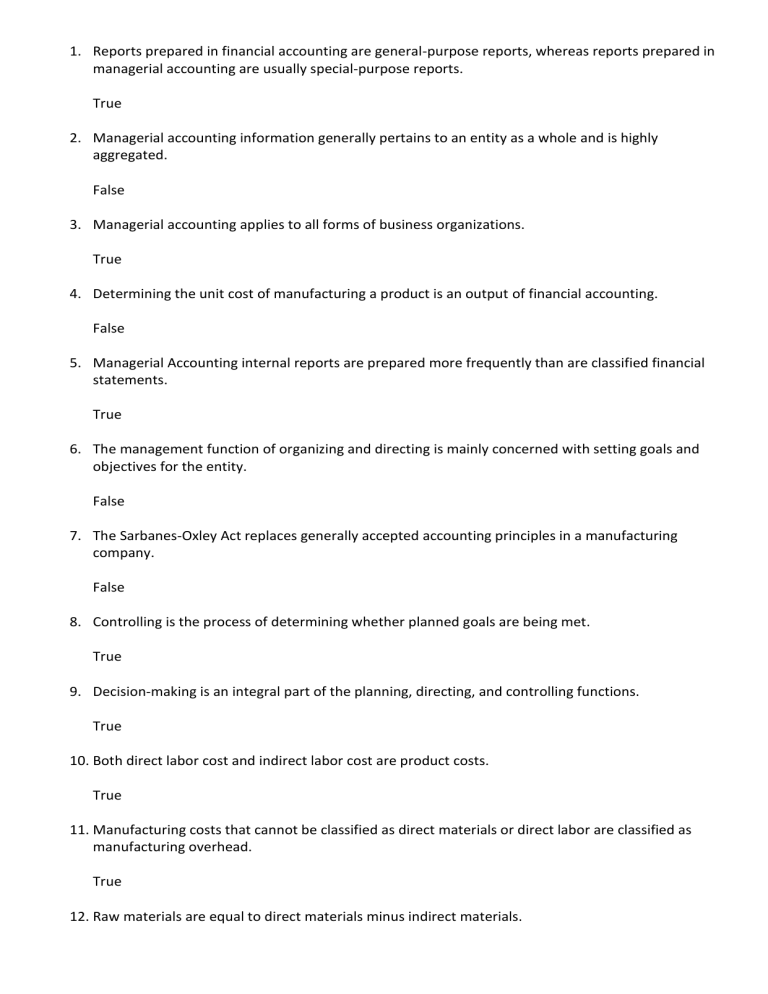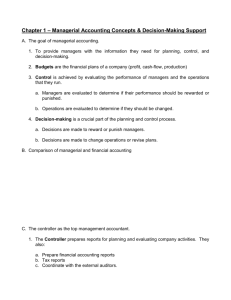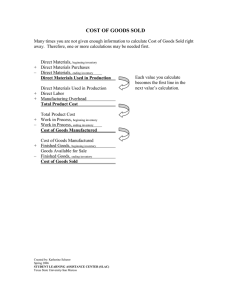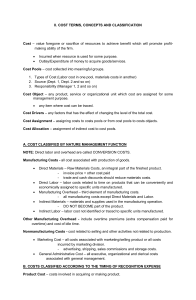
1. Reports prepared in financial accounting are general-purpose reports, whereas reports prepared in managerial accounting are usually special-purpose reports. True 2. Managerial accounting information generally pertains to an entity as a whole and is highly aggregated. False 3. Managerial accounting applies to all forms of business organizations. True 4. Determining the unit cost of manufacturing a product is an output of financial accounting. False 5. Managerial Accounting internal reports are prepared more frequently than are classified financial statements. True 6. The management function of organizing and directing is mainly concerned with setting goals and objectives for the entity. False 7. The Sarbanes-Oxley Act replaces generally accepted accounting principles in a manufacturing company. False 8. Controlling is the process of determining whether planned goals are being met. True 9. Decision-making is an integral part of the planning, directing, and controlling functions. True 10. Both direct labor cost and indirect labor cost are product costs. True 11. Manufacturing costs that cannot be classified as direct materials or direct labor are classified as manufacturing overhead. True 12. Raw materials are equal to direct materials minus indirect materials. False 13. Raw materials that can be conveniently and directly associated with a finished product are called materials overhead. False 14. The total cost of a finished product does not generally contain equal amounts of materials, labor, and overhead costs. True 15. Direct materials costs and indirect materials costs are manufacturing overhead. False 16. Period costs include selling administrative expenses. True 17. Indirect materials and indirect labor are both inventoriable costs. True 18. Direct materials and direct labor are the only product costs. False 19. Total period costs are deducted from total cost of work in process to calculate cost of goods manufactured. False 20. Period costs are not inventoriable. True 21. Ending finished goods inventory appears both on the balance sheet and the income statement of a manufacturing company. True 22. The beginning WIP inventory appears on both the balance sheet and the CoGS schedule of a manufacturing company. False 23. In calculating gross profit for a manufacturing company, the CoGS manufactured is deducted from net sales. False 24. Finished goods inventory does not appear on a CoGS manufactured schedule. True 25. If the ending WIP inventory is greater than the beginning WIP inventory, then the CoGs manufactured will be less than total manufacturing costs for the period. True 26. Finished goods inventory for a manufacturing company is equivalent to merchandise inventory for a merchandising company. True 27. Raw materials inventory shows the cost of completed goods available for sale to customers. False 28. The balanced scorecard approach attempts to maintain as little inventory on hand as possible. False 29. The supply chain is all the activities associated with providing a product or service. False 30. Many companies have significantly lowered inventory levels and costs using just-in-time inventory methods. True 31. Managerial accounting is primarily concerned with managers and external users. False 32. Planning involves coordinating the diverse activities and human resources of a company to produce a smooth-running operation. False 33. When the physical association of raw materials with the finished product is too small to trace in terms of cost, they are usually classified as indirect materials. True 34. Product costs are also called inventoriable costs. True 35. Direct materials become a cost of the finished goods manufactured when they are acquired, not when they are used. False 36. The sum of the direct materials costs, direct labor costs, and beginning work in process is the total manufacturing costs for the year. False 37. In a manufacturing company balance sheet, manufacturing inventories are reported in the current assets section in the order of their expected use in production, False





